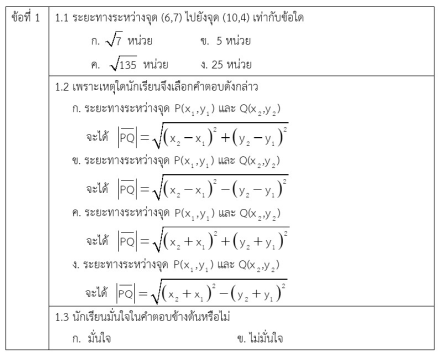Development of The New Four-tier Diagnostic Test for Diagnosing Mathematics Misconception
Keywords:
New Four-tier, Diagnostic Test, Diagnosing, Mathematics MisconceptionAbstract
The purposes of this study were 1) to compare diagnostic results of the three-tier and the new four-tier diagnostic tests in diagnosing mathematical misconceptions, and 2) to analyze the congruence among diagnostic results from the three-tier, the new four-tier diagnostic test, and think-aloud interviews. The development was separated into two phases: exploring misconceptions and developing and validating the psychometric properties of the three-tier and the new four-tier diagnostic tests for diagnosing mathematical misconceptions. A total of 60 eleventh-grade students participated in the new four-tier diagnostic testing. Research instruments included interview forms, the three-tier diagnostic test, and the new four-tier diagnostic test. The data were analyzed using descriptive statistics, difficulty index, discrimination index, reliability, Pearson’s correlation, and criterion-related validity. The research findings indicate that 1) the results of the study showed a high correlation level (r = .976, p < .001) between the three-tier and the new four-tier diagnostic tests, and 2) the correlation between diagnostic results of the new four-tier diagnostic test and think-aloud interviews was not different from the results of the three-tier diagnostic and think-aloud interviews.
References
ธนบดี อินหาดกรวด. (2554). การเปรียบเทียบผลการวินิจฉัยมโนทัศน์ที่คลาดเคลื่อนในวิชาชีววิทยาของนักเรียนชั้นมัธยมศึกษาตอนปลายระหว่างแบบสอบวินิจฉัยแบบเลือกตอบสามระดับและสี่ระดับ [วิทยานิพนธ์ปริญญามหาบัณฑิต, จุฬาลงกรณ์มหาวิทยาลัย]. CUIR. http://cuir.car.chula.ac.th/handle/123456789/60108
ธัญญารัตน์ จูมแพง. (2551). การศึกษาการเปลี่ยนแปลงมโนคติและระดับความเข้าใจทางเรขาคณิตของนักเรียนตามกรอบแนวคิดของ Van Hiele เรื่อง เรขาคณิตวิเคราะห์เบื้องต้น ชั้นมัธยมศึกษาปีที่ 4 [วิทยานิพนธ์ปริญญามหาบัณฑิต ไม่ได้ตีพิมพ์]. มหาวิทยาลัยขอนแก่น.
มนัสสิริ อินทร์สวาท. (2559). การเปรียบเทียบคุณภาพของแบบทดสอบวินิจฉัยแบบสามระดับสำหรับมโนทัศน์ที่คลาดเคลื่อนทางคณิตศาสตร์ที่ใช้ระดับความมั่นใจที่แตกต่างกัน [วิทยานิพนธ์ปริญญามหาบัญฑิต, จุฬาลงกรณ์มหาวิทยาลัย]. CUIR. http://cuir.car.chula.ac.th/handle/123456789/52379
วิยดา ซ่อนขำ. (2551). การสร้างแบบทดสอบวินิจฉัยจุดบกพร่องในการเรียนวิชาคณิตศาสตร์ เรื่อง จำนวนและการดำเนินการ สำหรับนักเรียนชั้นมัธยมศึกษาปีที่ 3 [วิทยานิพนธ์ปริญญามหาบัณฑิต ไม่ได้ตีพิมพ์]. มหาวิทยาลัยศรีนครินทรวิโรฒ.
เวชฤทธิ์ อังกนะภัทรขจร. (2551). การพัฒนากิจกรรมการเรียนรู้แบบการสอนแนะให้รู้คิด (CGI) ที่ใช้ทักษะการใช้เหตุผลและการเชื่อมโยงโดยบูรณาการสาระการเรียนรู้คณิตศาสตร์ เรื่อง การวิเคราะห์ข้อมูลกับสิ่งแวดล้อมศึกษาสำหรับนักเรียนชั้นประถมศึกษาปีที่ 6 [วิทยานิพนธ์ปริญญาดุษฎีบัณฑิต, มหาวิทยาลัยศรีนครินทรวิโรฒ]. SWU IR. http://thesis.swu.ac.th/swudis/Math_Ed/Vetcharit_A.pdf
ศิริชัย กาญจนวาสี. (2563). ทฤษฎีการทดสอบแนวใหม่ (พิมพ์ครั้งที่ 5). สำนักพิมพ์จุฬาลงกรณ์มหาวิทยาลัย.
Anam, R. S., Widodo, A., Sopandi, W., & Wu, H. K. (2019). Developing a five-tier diagnostic test to identify students’ misconceptions in science: An example of the heat transfer concepts. Elementary Education Online, 18(03), 1014-1029.
Putra, A S U., Hamidah, I., & Nahadi. (2020). The development of five-tier diagnostic test to identify misconceptions and causes of students’ misconceptions in waves and optics materials. Journal of Physics: Conference Series, 1521(1). http://doi:10.1088/17426596/1521/2/022020
Qonita, M., & Ermawati, F. U. (2020). The validity and reliability of five-tier conception diagnostic test for vector concepts. Journal Inovasi Pendidikan Fisika, 9(03), 459-465.
Rifat, Shafwatul, Anam., Ari, Widodo., Wahyu, Sopandi., & Hsin-Kai, Wu. (2019). Developing a five-tier diagnostic test to identify students' misconceptions in science: an example of the heat transfer concepts. Elementary Education Online, 18(3), 1014-1029. https://doi.org:10.17051/ilkonline.2019.609690
Translated Thai References
Angganapattarakajorn, V. (2008). Development of instructional activities based on cognitive guided instruction through reasoning and connection skills that integrate mathematics content on data analysis and environmental science for grade 6 students [Doctoral dissertation, Srinakharinwirot University]. SWU IR. http://thesis.swu.ac.th/swudis/Math_Ed/Vetcharit_A.pdf
Inhadkruad, D. (2017). A comparison of misconception diagnostic results between three-tier and four-tier diagnostic test in biology for secondary students [Master’s thesis, Chulalongkorn University]. CUIR. http://cuir.car.chula.ac.th/handle/123456789/60108
Insawat, M. (2016). A comparison of the quality of three-tier diagnostic test of mathematical misconception using different levels of confidence [Master’s thesis, Chulalongkorn University]. CUIR. http://cuir.car.chula.ac.th/handle/123456789/52379
Jumepaeng, T. (2012). The study of matthayomsuksa 4 students’ conceptual change and geometric understanding based on van Hiele’s theory about analytic geometry [Unpublished master’s thesis]. Khon Kaen University.
Kanjanawasee, S. (2020). Modern test theory (5th ed). Chulalongkorn university press.
Sonkhum, W. (2008). A construction of mathematics learning diagnostic test on number and numerical works for matthayomsuksa 3 students [Unpublished master’s thesis]. Srinakharinwirot University.

Downloads
Published
How to Cite
Issue
Section
License
Copyright (c) 2024 The Authors

This work is licensed under a Creative Commons Attribution-NonCommercial-NoDerivatives 4.0 International License.
All published content in JRM is licensed under a Creative Commons Attribution-NonCommercial-NoDerivatives 4.0 International License (CC BY-NC-ND 4.0).


